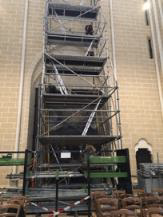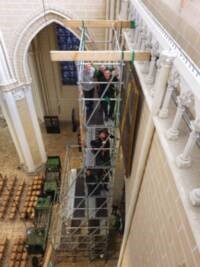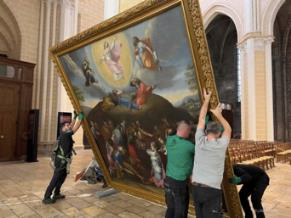The painting of the Transfiguration is put up in the south transept after restoration. This restoration project was co-financed by AFC with the French state and DRAC (Direction Régionale des Affaires Culturelles, Centre Val de Loire). AFC contributed 32,000 Euros.
The monumental 3.80 m by 3.60 m painting (with frame) represents the Transfiguration from the composition of Raphael’s famous 1520 painting for Cardinal Julius of Medici (today on the picture rails of the Vatican Pinacoteca). Classified on January 29, 1982, this oil on canvas remains anonymous and no signature was revealed by the restoration.
Thanks to the testimony of the historian Bulteau, we know that the painting comes from the former convent of the Jacobins of Chartres (current location of the convent of the Sisters of Saint-Paul) and would have taken place in 1791 in the north transept where a chapel called the Transfiguration had been built against the east wall (see opposite, the altar on the plan of Bulteau ).
Taking advantage of the restoration of the South Transept, the painting was taken down on July 1, 2021. At that time, restorers Elodie Delaruelle, Lucia Tranchino and Jean Joyerot alerted the DRAC (CRMH) of fragile areas and defects in the lining. Despite a first restoration in the early 1990s, the painting presented indeed disorders and a strong fouling; finally the weight of the frame created tensions on the chassis and deformations detrimental for conservation. Four months of work were necessary to carry out this restoration with a team of ten restorers.


The restoration revealed information about the history of the work. Elodie Delaruelle was able to identify that the lower part of the painting relating to the Healing of the paralytic was better preserved than the upper part that depicts the actual episode of the Transfiguration of Christ. By the style and nature of the preparatory layer, the original part could be dated to the 17th century. As for the upper part, many characters are reinvented and simplified in a 19th century spirit and technique. Finally, a last stage seems to have been the rechampi of the sky and of the top of the mountain at the end of the 19th or in the 20th centuries.
This collected information suggests greater wear in the upper part of the painting. The restorer even suggests possible traces of the 1836 fire of the cathedral, when the roof wooden framework was completely destroyed. While the stone vaults withstood the fire, water sprayed on, or dripping from them, may have damaged the painted canvas. This exciting hypothesis, put forward by the restorers, will be difficult to confirm for lack of precise and detailed testimonies about the evacuation of furnishings and movable objects, but invites us to look at the history of the furnishings of the cathedral before and after the Revolution.
This exemplary restoration, heavy in terms of human and financial resources, was carried out by a team of ten conservators-restorers of paintings, led by Elodie Delaruelle and Lucia Tranchino, and by Maxime Seigneury for the gilded wooden frame. To reinstall the painting in the South Transept, the Bovis company, specialized in the handling of works of art, was chosen to set up a scaffolding to hang the painting in its original setting, at the height of 11 meters high under the South Rose and five lancets.
Source: Website, Ministry of Culture. France, DRAC. October 2023.
Help us restore and preserve the cathedral of Notre-Dame de Chartres
Your contributions are tax deductible in the United States to the extent allowed by law.


